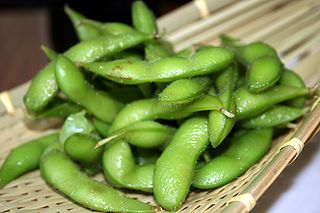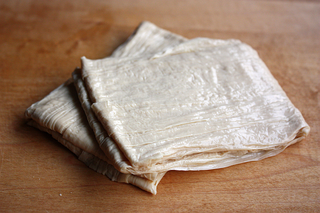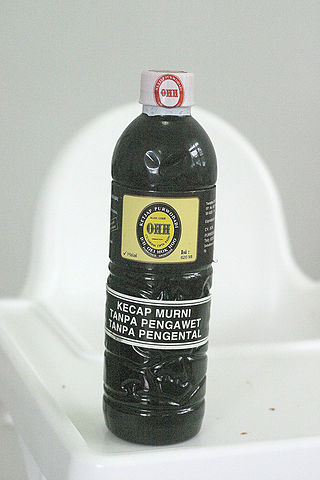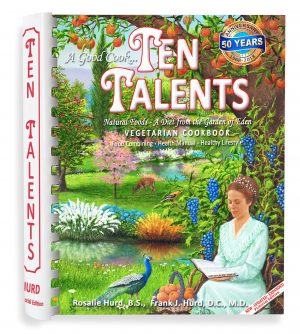Related Research Articles

The soybean, soy bean, or soya bean is a species of legume native to East Asia, widely grown for its edible bean, which has numerous uses.

Edamame is a Japanese dish prepared with immature soybeans in the pod. The pods are boiled or steamed and may be served with salt or other condiments. The dish has become popular across the world because it is rich in vitamins, dietary fiber, and isoflavones. When the beans are outside the pod, the term mukimame is also sometimes used in Japanese. Edamame are a common side dish in Japanese cuisine and as an appetizer to alcoholic beverages such as beer or shōchū. As an ingredient Edamame are found in both sweet and savory dishes such as takikomi gohan, tempura, and zunda-mochi.

Kikkoman Corporation is a Japanese food manufacturer. Its main products and services include soy sauce, food seasoning and flavoring, mirin, shōchū, and sake, juice and other beverages, pharmaceuticals, and restaurant management services.

Soy milk, also known as soya milk or soymilk, is a plant-based drink produced by soaking and grinding soybeans, boiling the mixture, and filtering out remaining particulates. It is a stable emulsion of oil, water, and protein. Its original form is an intermediate product of the manufacture of tofu. Originating in China, it became a common beverage in Europe and North America in the latter half of the 20th century, especially as production techniques were developed to give it a taste and consistency more closely resembling that of dairy milk. Soy milk may be used as a substitute for dairy milk by individuals who are vegan or lactose intolerant.

Amazake is a traditional sweet, low-alcohol or non-alcoholic Japanese drink made from fermented rice. Amazake dates from the Kofun period, and it is mentioned in the Nihon Shoki. It is part of the family of traditional Japanese foods made using the koji mold Aspergillus oryzae, which also includes miso, soy sauce, and sake.

Tofu skin, Yuba, beancurd skin, beancurd sheet, or beancurd robes is a food product made from soybeans. During the boiling of soy milk, in an open shallow pan, a film or skin composed primarily of a soy protein-lipid complex forms on the liquid surface. The films are collected and dried into yellowish sheets known as tofu skin. Since tofu skin is not produced using a coagulant, it is not technically a proper tofu; however, it does have similar texture and flavor to some tofu products.
John W. Daniels was an American businessman. He was the co-founder and chairman of Archer Daniels Midland.

Taurida Oblast was an oblast (province) of the Russian Empire. It roughly corresponded to most of the Crimean Peninsula and parts of the Southern Ukraine regions. It was created out of territories of the Crimean Khanate, which Russia annexed in 1783. In 1796 it was merged into the Novorossiya Governorate. The name Taurida comes from the old Greek name for the area, Tauris, as in ancient times several Greek city-states had developed colonial outposts in the area.
The College of Agriculture, Pantnagar, India, is a constituent of Govind Ballabh Pant University of Agriculture & Technology, Pantnagar. It was opened on 17 November 1960 when Jawaharlal Nehru, the first Prime Minister of India, inaugurated the university. It has a triple mandate of teaching, research and extension.

Asgrow is a seed company owned and operated by Bayer Crop Science.
Friedrich J. Haberlandt (1826–1878) was a professor of agriculture at the Hochschule fuer Bodenkultur in Vienna, Austria-Hungary. He is best known for his book Die Sojabohne, which introduced soybean cultivation to Western and Central Europe.

Wotou or wowotou, also called Chinese cornbread, is a type of steamed bread made from cornmeal in Northern China.

Sweet soy sauce is a sweetened aromatic soy sauce, originating in Indonesia, which has a darker color, a viscous syrupy consistency, and a molasses-like flavor due to the generous addition of palm sugar or jaggery. Kecap manis is widely used with satay. It is similar to, though finer in flavor than, Chinese Tianmian sauce (tianmianjiang). It is by far the most popular type of soy sauce employed in Indonesian cuisine and accounts for an estimated 90 percent of the nation's total soy sauce production.

Ten Talents is a vegetarian and vegan cookbook originally published in 1968 by Rosalie Hurd and Frank J. Hurd. At the time, it was one of the few resources for vegetarian and vegan cooks. The cookbook promotes Christian vegetarianism and a Bible-based diet, in keeping with teachings of the Seventh-day Adventist Church. By 1991, the 750-recipe cookbook was entering its 44th printing and had sold more than 250,000 copies. An expanded edition with more than 1,000 recipes was issued in 2012.

The Farm Vegetarian Cookbook is a vegan cookbook by Louise Hagler, first published in 1975. It was influential in introducing Americans to tofu, included recipes for making and using tempeh and other soy foods, and became a staple in vegetarian kitchens.

Otto Heinrich Carque was a French–American businessman, fruit grower, naturopath, raw foodist, vegetarian and writer. He was the first to use the term natural food.
William Roy Shurtleff also known as Bill Shurtleff is an American researcher and writer about soy foods. Shurtleff and his former wife Akiko Aoyagi have written and published consumer-oriented cookbooks, handbooks for small- and large-scale commercial production, histories, and bibliographies of various soy foods. These books introduced soy foods such as tofu, tempeh, and miso on a wide scale to non-Asian Westerners, and are largely responsible for the establishment of non-Asian soy food manufacturers in the West beginning in the late 1970s. In 1980, Lorna Sass wrote in The New York Times, "The two people most responsible for catapulting tofu from the wok into the frying pan are William Shurtleff and Akiko Aoyagi.” In 1995, Suzanne Hamlin wrote in The New York Times, “At the turn of the century there were two tofu suppliers in the United States. Today there are more than 200 tofu manufacturers...and tofu can be found in nearly every supermarket."

Lenna Frances Cooper was an American dietitian and co-founder of the Academy of Nutrition and Dietetics. She has been called “a pioneer in vegetarian nutrition and dietetics.”
Akiko Aoyagi is an American cookbook author and artist. She is best known as the recipe developer, illustrator, and co-author of the soy-based cookbook series The Book of Tofu (1975), The Book of Miso (1976), and The Book of Tempeh (1979), that had a strong impact on the natural foods movement within the American counterculture.
References
- ↑ "PIPER, Charles Vancouver". The International Who's Who in the World. 1912. p. 858.
- ↑ Frye, Theodore C. (1907). "Reviewed work: The Flora of the State of Washington, Charles V. Piper". The Washington Historical Quarterly. 1 (2): 73–77. JSTOR 40473773.
- ↑ Abrams, L. (1916). "Review of Flora of the Northwest Coast" (PDF). Science. 43 (1122): 932–933. doi:10.1126/science.43.1122.932.
- ↑ Rydberg, P. A. (1916). "Piper and Beattie's Flora of the Northwest Coast". Torreya. 16 (6): 143–146. JSTOR 40595716.
- ↑ Perkins; Woods; WSU Libraries.
- ↑ Shurtleff, William; Aoyagi, Akiko (2017). William Joseph Morse - History of His Work with Soybeans and Soyfoods (1884-2017): Extensively Annotated Bibliography and Sourcebook (PDF). Lafayette, CA: Soyinfo Center. ISBN 9781928914952.
With many documents by and about Charles V. Piper.
- ↑ International Plant Names Index. Piper.